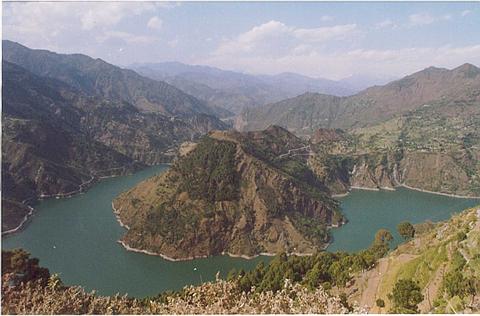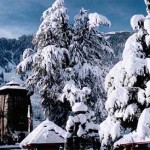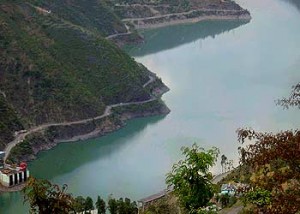 A charismatic medieval town in the lower Himalayan range, Chamba in Himachal Pradesh is situated in the north-western part of the state. A typical hill station amidst of verdant greenery, the lovely picnic spot is a cluster of tiny villages and unblemished rivers. A fabulous place decked with natural beauty, its staggeringly carved sandstone temples, entwined with the calm ambiance of the town is sure to make the visit a memorable one.
A charismatic medieval town in the lower Himalayan range, Chamba in Himachal Pradesh is situated in the north-western part of the state. A typical hill station amidst of verdant greenery, the lovely picnic spot is a cluster of tiny villages and unblemished rivers. A fabulous place decked with natural beauty, its staggeringly carved sandstone temples, entwined with the calm ambiance of the town is sure to make the visit a memorable one.
Chamba, the district headquarters of Chamba district, is located on a plateau on the banks of the beautiful river Ravi. Zanskar and Dhaulad ranges in the western Himalayas provides a magical charm to the picturesque atmosphere of Chamba. This historic town was established by Raja Sahil Varman of Pahari dynasty during the 10th century and is mentioned in the famous book Rajtharangini. Named after Champavati the king’s daughter, Chamba today presents as an exemplary township, famed for its countless temples, charming folklore and dense forests.
At an altitude of 930m, Chamba ascends over Ravi River parting fertile gorges and intense forests in its wake. Blessed with a rich fauna, the dense forests of Chamba are the natural habitat of so many rare species in the animal kingdom. With numerous species of birds, appealing gorges and cascading streams of water, Chamba presents an alluring scenery around.
A place where festivals and celebrations mark the life of the common man, Chamba is all set to attract the tourists with its charming temples and serene beauty.
Chamba, is a small but attractive tourist destination of Himachal Pradesh, is known for its exquisite natural beauty. The place, located amidst picturesque and verdant valleys, is visited by tourist round the year. Sub-Himalayan range of mountains, full of diverse flora and fauna, make Chamba an exhilarating experience
History
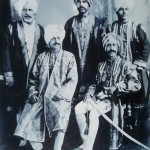 Chamba is the only state in northern India to preserve a well-documented history from circa 500 A.D. Its high mountain ranges have given it a sheltered position and helped in preserving its centuries old relics and numerous inscriptions. The temples erected by rajas of Chamba more than a thousand years age continue to be under worship and the land grant-deeds executed on copper plates by them continue to be valid under the law.
Chamba is the only state in northern India to preserve a well-documented history from circa 500 A.D. Its high mountain ranges have given it a sheltered position and helped in preserving its centuries old relics and numerous inscriptions. The temples erected by rajas of Chamba more than a thousand years age continue to be under worship and the land grant-deeds executed on copper plates by them continue to be valid under the law.
Regarding the early history of this region it is believed that this area was at time inhabited by certain Kolian tribes,which were later, subjugated by the Khasas. The Khasas too after a time came under the sway of Audumbaras (2nd century B.C.). The Audmabaras had republican form of government and worshiped Shiva as their principal deity. From the Gupta period (4th Centaury A.D.) the Chamba region was under the control of Thakurs and Ranas who considered themselves superior to the low tribes of Kolis and Khasas. With the rise of Gurjara Pratiharas ((7th Centaury A.D.) the Rajput Dynasties came to power.
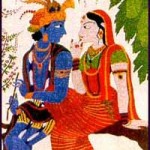 In circa 500 A.D., a legendry hero called Maru migrated to north-west from Kalpagrama (a mythical place from where majority of the Rajput dynasties claim their descent) and founded Brahamputra (Bharmour) in the valley of the Budhal river, seventy five kilometer to the east of present Chamba town. His successors continued to rule over the country from that capital city for over three hundred years until Sahilla Varman shifted his capital from Brahamputra to the more centrally located plateau in the lower Ravi valley. He named the town after his beloved daughter Champa. His rani voluntarily offered herself as a scarifies to bring water for the town’s people through a running channel which takes origin at a place called Bhalota..
In circa 500 A.D., a legendry hero called Maru migrated to north-west from Kalpagrama (a mythical place from where majority of the Rajput dynasties claim their descent) and founded Brahamputra (Bharmour) in the valley of the Budhal river, seventy five kilometer to the east of present Chamba town. His successors continued to rule over the country from that capital city for over three hundred years until Sahilla Varman shifted his capital from Brahamputra to the more centrally located plateau in the lower Ravi valley. He named the town after his beloved daughter Champa. His rani voluntarily offered herself as a scarifies to bring water for the town’s people through a running channel which takes origin at a place called Bhalota..
The Muslims never invaded Chamba, though it had its occasional fights with the neighboring states in the hills having similar cultural background. Thus,the damage to Chamba from these invasions was seldom serious and never beyond the possibility of repair. Even the powerful Mughals were kept at bay on account of difficulties involved in communications and long distances. Akbar tried to extend a loose control over the hill states including Chamba and attached fertile tracts of these states to the imperial territory south of Dhauladhar. Aurangzeb once issued orders to the Raja of Chamba Chatter Singh (1664-1694AD) to pull down the beautiful temples of Chamba. But instead the raja in clear defiance to the Mughal ruler placed glided pinnacles on the temples. He was ordered to come down to Delhi to face the imperial wrath. But Aurangzeb himself had to leave for the Deccan from where he could not disentangle till the end of his life. On the whole, the northern India experienced comparatively peaceful condition during the Mughal regime Raja Prithvi Singh (1641-1664 AD), a handsome and a gallant knight was favourite of Shahjahan and visited the imperial court many times. He introduced the Mughal style of court life including Mughal-Rajput art. By the last quarter of 18th centaury the Sikhs forced the hill states to pay tribute to them. Maharaja Ranjit Singh systematically deposed the hill prices including the more powerful Kangra ruler Sansar Chand Katoch but spared Chamba in lieu of the services Wazir Nathu (of Chamba) had rendered him on two occasions. In 1809 A.D. the Wazir had made himself useful to the Maharaja by negotiating his agreement with Raja Sansar Chand Katoch, of Kangra. Again in A.D.1817 he had saved Ranjit Singh’s life by offering his horse at a critical moment during formers winter campaign in Kashmir. After Ranjit Singh’s death Chamba became un-protected and was drawn into the vortex of the disintegration of the Sikh Kingdom. The Sikh army invaded the British territory in A.D. 1845 and the troops of Sikh army, which were stationed in Chamba, were with drawn. When Sikh’s were defeated it was decided to merge Chamba in Jammu and Kashmir but on account of the timely intervention of Wazir Bagha (of Chamba) it was taken under the British control and subjected to the annual tribute of 12,000 rupees. The Raja’s who saw something of British hegemony were Sri Singh, Gopal Singh, Sham Singh, Bhuri Singh, Ram Singh and laxman Singh. Their relations with the British political officers seem to be cordial and Chamba witnessed many reforms.
Before Raja Sahilla Varman came on the same the Chamba region was divided into bits and pieces of territory called Rahnu occupied by numerous Ranas and petty Chieftains who carried on relentless warfare with each other. Raja Sahilla Verman subjugated the Ranas and unified the territory. Rajas, therefore, for better administration divided Chamba into five zones known as Mandlas. These Mandlas were later renamed as Wizarats. This five fold division of Chamba region continues till today. The Wizarats are now called Tehsils. These are Bharmour, Chamba, Bhattiyat, Churah and Pangi.
Place of Interest
Church of Scotland
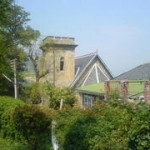 A century old structure well known for its fine stonework, the Church of Scotland was founded by the mission of Church of Scotland. Its arched windows and intricate carvings represent the Scottish style architecture. Constructed with modest bricks, its austere fascia & ornamental foundation lies entrenched in its baked walls. Built in the year 1903, this church building is now converted in to a library by the authorities.
A century old structure well known for its fine stonework, the Church of Scotland was founded by the mission of Church of Scotland. Its arched windows and intricate carvings represent the Scottish style architecture. Constructed with modest bricks, its austere fascia & ornamental foundation lies entrenched in its baked walls. Built in the year 1903, this church building is now converted in to a library by the authorities.
Located in Chamba market, this beautiful building of the protestant Christians is also called as St Andrew’s Church. The Church building has stood the test of time and the brick wall around the church is the only new construction one can see in the church premises.
Central Park
One among the imperative attractions of Chamba is the magnificent Central Park which provides panoramic views of the entire hill station. A verdant field, which is the jamboree of all the activities in the town, the central park, is the largest crowd puller in the city in recent years. This fabulous spot, on the precipice over River Ravi is also known as Chaugan and the most remarkable construction in this place is the Gandhi gate that immortalizes Lord Curson’s visit to Chamba.
The park was a prominent spot for cricket tournaments during the British reign and now it houses various fairs and carnivals apart from being a Polo ground. This meadow is the hub of local trade and its vast stretch of luscious greenery makes it a popular esplanade. A beautiful temple of lord Shiva, where the famous Manimahesh Yatra takes place is an added attraction here.
Laxmi Narayan Temple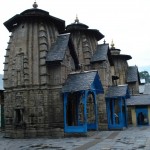
A 10th century temple built in the Shikhara style by Sahil Verman, Laxmi Narayan Temple is the oldest and the largest of all the temples in Chamba. The darshan time of the temple is scheduled in two halves between 6 am to 12.30pmand from 2.30 to 8.30 pm
These temple complex houses six shrines dedicated to either Vishnu or Shiva. The main idol of Lord Vishnu is made up from a rare piece of Marble that has a glittering appearance. The temple complex also holds shrines dedicated to other deities like Gauri Shankar, Radha and Krisha. The temple consists of Garbhgriha, Shikhara or Bimana and a mandapa. The temples are constructed in such a way that it perfectly suits the climatic conditions of the locality.
Bhuri Singh Museum
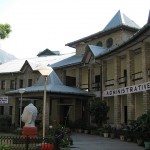 Officially started in 1908, the Bhuri Singh Museum at Chamba is named after the illustrious King Raja Bhuri, who had contributed his family compilation of paintings to the museum. The inscription in Sarda scripts that are exhibited in the museum give vital information on the medieval account of Chamba.
Officially started in 1908, the Bhuri Singh Museum at Chamba is named after the illustrious King Raja Bhuri, who had contributed his family compilation of paintings to the museum. The inscription in Sarda scripts that are exhibited in the museum give vital information on the medieval account of Chamba.
The Chamba rulers were great patrons of arts and culture, and the Museum houses outstanding collections of Guler-Kangra style Paintings. It is sure that the Basohli style paintings, which illustrates the Bhagwat Purana and Ramayana catches the attention of the visitor. Other fascinating attraction of the museum is the Chamba-Rumals that are famed for stunning embroidery work. In addition to all these, the Museum also holds Armour and arms, coins, hill jewelry and costumes, musical instruments
The old museum building stands it way to the newly built mammoth structure, which was constructed in 1975. Except on holidays and Monday the museum remains open from 10 am to 5 pm throughout the year.
Chamunda Devi Temple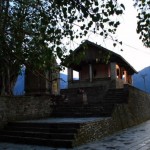
Situated on the banks of the beautiful Baner River is the famous Chamunda Devi Temple. This temple is dedicated to Goddess Kali, the ferocious incarnation of Durga Devi. Situated in a lovely ambience, this temple commands the pretty sights of the majestic mountains and the woody forests of Lahl and Pathiar.
Chamunda Devi temple is believed to be 750 years old and it holds a fabulous legend, which says that it was here that the Goddess Ambika killed the two demons by name Munda and Chanda. The main deity in the temple is wrapped in a red cloth so that the devotees are not allowed to touch.
A huge temple complex, the Chamunda Devi Temple also holds a boulder, which depicts the stone lingam of Lord Shiva. The temple premises are enshrined with the images of numerous other gods and goddess.
Hariraya Temple
Dedicated to the lord Vishnu, Shri Hariraya temple is located adjacent to the Central Park. Built in stone, this temple also exhibits the Shikhara style architecture. The deity’s bronze image with the three face is made out from eight different materials that presents a fine implementation. This 11th century temple is the abode of the other deities such as lord Shiva, Surya and Aruna. The main deity is artistically ornamented with bracelets, finger-rings, armlets, a beaded garland, mukut, necklaces, and kundals.
Finely carved Shikharas and the superb sculpture of Vishnu straddling six horses have got an enchanting appeal. The saffron coloured shrine is supposed to have great antique value. It is the only structure that has been coated with saffron colour and stands out because of its prominent colour. The temple enshrines a marvelous bronze image of Lord Vishnu in the form of Chaturmurti.
Rang Mahal
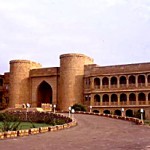 Located in Surara Mohalla, Rang Mahal was founded by Raja Umed Singh. Once the abode of a division of the ruling reign this wonderful palace displays a perfect mixture of British and Mughal style architecture. The walls of this 18th century monument are wizened with fine exemplars of Punjab hill style wall paintings, which portray the life of Lord Krishna.
Located in Surara Mohalla, Rang Mahal was founded by Raja Umed Singh. Once the abode of a division of the ruling reign this wonderful palace displays a perfect mixture of British and Mughal style architecture. The walls of this 18th century monument are wizened with fine exemplars of Punjab hill style wall paintings, which portray the life of Lord Krishna.
A number of ornamental and vibrant wall paintings have been detached and taken to Delhi National Museum. The Rang Mahal or the old palace houses the Himachal Emporium, which functions between 10 am to 1 pm and 2 to 5 pm from Monday to Saturday. The Emporium is shopper’s delight, which sells exquisite items like hand made rumals, shawls made in wooden looms and chappels.
Chamera dam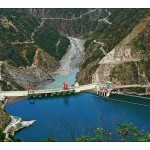
Impounding River Ravi, Chamera Dam is the lifeline of Dalhousie as the city survives on its water. The dam is situate on Chamera Lake, around 35 km from Dalhousie. There are no aquatic beings in the lake, thus making it ideal for water sports.
Some of the most popular adventure that can be enjoyed here are rowing, paddle boating, motor boating, sailing, canoeing, angling and kayaking. Himachal government also provides shikaras and house boat rides on the site.
Akhand Chandi Palace
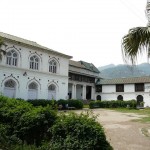 Once the residential building of the royal Chamba Family, Akhand Chandi Palace was built by King Umed Singh around 1747-1765 AD and with the help of British Engineers, it was renovated by the King Sham Singh. This gorgeous mansion reflects a unique style of architecture. The descendants of the great regime handed over this beautiful building to the state government and like many other buildings of the yesteryears, this gorgeous citadel is swiftly parting with its former glory.
Once the residential building of the royal Chamba Family, Akhand Chandi Palace was built by King Umed Singh around 1747-1765 AD and with the help of British Engineers, it was renovated by the King Sham Singh. This gorgeous mansion reflects a unique style of architecture. The descendants of the great regime handed over this beautiful building to the state government and like many other buildings of the yesteryears, this gorgeous citadel is swiftly parting with its former glory.
An elegant structure that was famed for its glasswork and painted walls are in a ruined condition due to lack of proper maintenance. The ceilings with delicate carpentry reveal the artistic excellence of the craftsman. Besides this, the panoramic view of the near by temples and other mansions from here is an added attraction.
Chobia Pass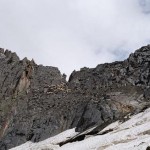
Situated between the two minor peaks of the Pir Panjal Range – Tent Peak and Barakanda Peak in Bharmour village, Chobia Pass is located at a height of 5000 m above sea-level. The pass offers magnificent views of the Zanskar range in the north and Manimahesh range in the south.
Chobia Pass has greats routes for trekking and serve as an acclimatization trek before attempting the arduous Kang La Pass in Miyar Valley ahead. It is a very challenging trek, and only experienced trekkers are advised to indulge here.
River Rafting
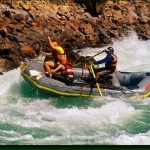 River Rafting is an upcoming sport in Chamba. The sport can be enjoyed on River Ravi and Saal. The best time for this adventure is from June till October. Private and government tour operators conduct this sport in Chamba.
River Rafting is an upcoming sport in Chamba. The sport can be enjoyed on River Ravi and Saal. The best time for this adventure is from June till October. Private and government tour operators conduct this sport in Chamba.
This is a small village located around 60 km from Chamba and is known for its picturesque beauty and ancient temples. Bharmour once served as the ancient capital of Chamba and is dominated by the Gaddi tribes. While in Bharmour, tourists should not miss shopping for the fruits and blankets.
The main tourist attractions here are archaeological temple remains dating back to more than 1,000 years. The most famous temples here are Lakshna Devi and Ganesh, known for their architecture patterns. Tourists are advised to enjoy an easy 4 km trek on the hill to the Chaurasi temple and enjoy the spectacular views. Pilgrims flock here to take a dip in the waters of the holy Manimahesh Lake (35 km uphill trek from Bharmour) during the Manimahesh Yatra held from August to September.
Trekking and mountaineering are a few challenging sports tourists can enjoy here. The regional center of mountaineering Institute of Manali is located here to assist the adventurers. The best time to visit Bharmour is during the months from April to October.
Khajjiar Lake
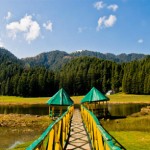 Khajjiar lake lies 32°26¢ north and 76° 32¢east about 6300 feet above sea level between Chamba and Dalhousie. Its area is approximately 5000 sq. yards but is constantly under threat from weeds. The average depth of the lake is sitated to be thirteen feet as per District Gazetteer. For the local people this lake holds sacredness and they beleive that it is unfathomable. The lake takes its name from Khajji Nag, the deity in the temple nearby. It is set in huge grassy glade with surroundings of evergreen cedars. The whole ensemble makes one think of a piece of sapphire set in the background of gold and emerald.
Khajjiar lake lies 32°26¢ north and 76° 32¢east about 6300 feet above sea level between Chamba and Dalhousie. Its area is approximately 5000 sq. yards but is constantly under threat from weeds. The average depth of the lake is sitated to be thirteen feet as per District Gazetteer. For the local people this lake holds sacredness and they beleive that it is unfathomable. The lake takes its name from Khajji Nag, the deity in the temple nearby. It is set in huge grassy glade with surroundings of evergreen cedars. The whole ensemble makes one think of a piece of sapphire set in the background of gold and emerald.
ManimaheshTemple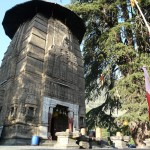
Located in the Budhil valley of Bharmaur at the foot of Manimahesh Kalish, the abode of Lord Shiva, this lake is the highest in the hierarchy of sacred waters of Chamba. The tarn of Manimahesh is situated at an altitude of about 13,000 feet, 32 23 north and 76 40 east. The tarn is smaller than the tarn of Khajjiar lake but is the most sacred. It is a great source of pilgrimage during Radha-asthmi and Janamashtmi every year when pilgrims from far and wide assemble for a holy dip here.
How To Reach Chamba
By Air
Gaggal airport in Kangra valley is the nearest airport. The airport is 185 km away from Chamba, which costs about Rs 3500 by Taxi cab. This airport connects domestic flights to Delhi. International travelers have to get connection through Delhi Airport. Delhi Airport is connected to all major cities in India and most of the foreign cities.
By Train
Pathankot is the nearest broad gauge railhed, which is 122 km away from Chamba town. Pathankot is well connected to Amritsar, Kolkata, Mumbai and Delhi.
By Bus
Regular bus services are available from Chamba to Dalhousie (56 km) and also to the nearby cities. Chamba to Dalhousie costs around Rs 150
General facts
State Himachal Pradesh
Population 460,887
Area 6528 km sq
Languages Hindi,pahari
Longitude 75°49
Latitude 32° 11′ 30″
Submit your review | |
